The Fundamental Unit of Life | NCERT Class 9 Science Notes, Explanation and Question Answer
The Fundamental Unit of Life CBSE Class 9 Science Chapter 5 – Complete explanation and Notes of the chapter ‘The Fundamental Unit of Life’.
Topics covered in the lesson are Introduction of Force, Newton’s third law of motion, Balanced and Unbalanced Forces, Law of conservation of momentum, Newton’s first law of motion, Newton’s second law of motion.
Here is the complete explanation of the chapter, along with all the important questions and NCERT solutions to book questions that have also been provided for the ease of students.
Class 9 Science Chapter 5 – The Fundamental Unit of Life
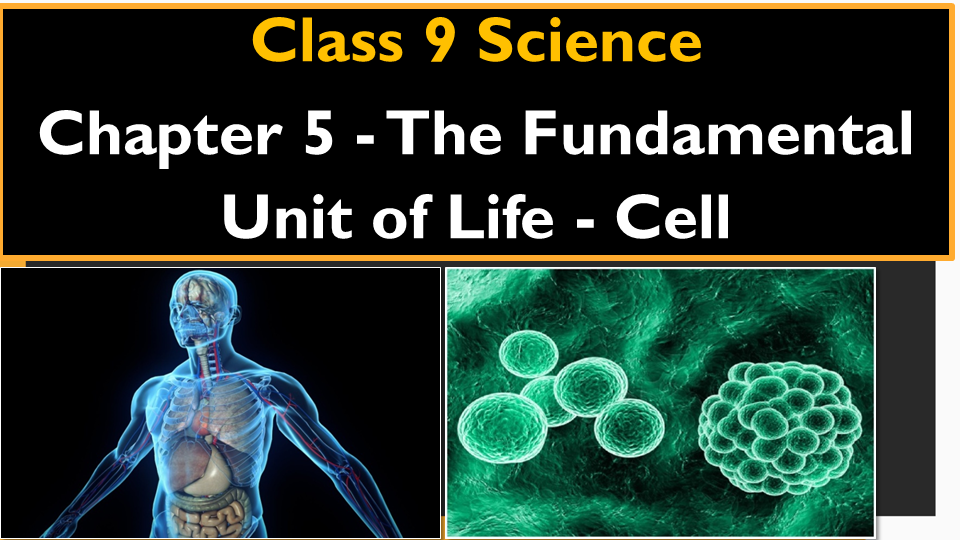
Topics to be Covered
- See Video Explanation of Chapter 5 The Fundamental Unit of Life
- Introduction of cell
- Cell organelles and their functions
- Discovery of cell
- diffusion and osmosis
- Cell theory
- types of solutions
- Prokaryotic and eukaryotic cell
- cell placed in different types of solution
- Cell shape and size
- Cell membrane and cell wall
- NCERT Book solutions
Also See: CBSE Science Syllabus for Class 10 2021-22
See Video for Explanation and Summary of the Lesson
Introduction of cell
As you all know the body of an individual is of complex type. If we study about the detailed structure of the human body or of any lower organism, we will come across many things that makeup the body. But at the smallest level, our body is made up of tiny units called cells. Let us learn about cell in detail.
Cell is often referred as “structural and functional unit of living organisms”. The reason is that the cell is the smallest unit of body and directly or indirectly, it is responsible for functions also. If we study about the hierarchy then we will notice that the level of organization is :

That means that the smallest unit of body is cell.

Discovery of cell
The cell was discovered by Robert Hooke in a thin slice of cork in 1665.
Cork is actually a dead part of tree that is bark of tree .He discovered it with the help of instrument called microscope. This microscope is an instrument that enables us to see those things that can’t be otherwise seen with the help of naked eye. It has the property to magnify the objects. He discovered with the help of instrument that is microscope which was discovered by Anton von Leeuwenhoek.

When he saw the internal structure of cork with the help of microscope it looked like compartments .So, earlier these cells were named as compartments but later on it was replaced by term cell.
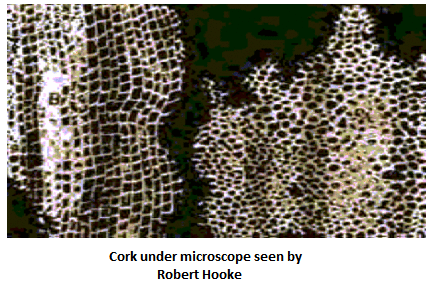
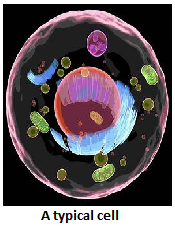
It was concluded that all the cells have three basic characteristics. –
They contain plasma membrane: – made up of lipid & proteins
They contain genes: – Genetic material in form of DNA or RNA containing genes is present.
They contain metabolic machinery: – Cytoplasm is present which contain organelles like mitochondria etc.
These all arts like plasma membrane, cytoplasm, RNA, DNA etc will be taken in to consideration step wise step. Let us first learn more about cell.
Top
Cell theory
To know more about cell, few scientists sum up their views about cell as cell theory. It was given by volunteers: Sheldon & Schwann.
According to this theory: –
Cell is the structural unit of life.
Cell is functional unit of life.
All cells arise from pre-existing cells. Every organism starts life as a single cell. (It was given by R. Virchow)
Types of cells – Prokaryotic and Eukaryotic cells
There are two main types of divisions of cells depending upon their basic and important difference in their structures. The types are:
- Prokaryotic (primitive cell)
- Eukaryotic (advanced type)
Prokaryotic and eukaryotic cell: The basic difference between the two is: In prokaryotic, the nuclear material lies naked in cytoplasm that is no special membrane is present that separates it from the cytoplasm. It is present as such in cytoplasm.
In eukaryotic, the nuclear material is well protected and enclosed by special membrane that is nuclear membrane .We can say in it the nucleus is present.
Let us some up more difference in them.
| Prokaryotic cell | Eukaryotic cell |
|
|
Top
Class 9 Science Chapter wise Explanation
| Chapter 1 Matter in Our Surroundings | Chapter 2 Is Matter around us Pure | Chapter 3 Atoms and Molecules |
| Chapter 4 The Structure of an Atom | Chapter 5 The Fundamental unit of life | Chapter 6 Tissues |
Cell shape and Cell size
Now, let’s talk about the cell shape and size. It is seen that cells can be of different shapes and sizes and even their number that make up a body can be different in different living forms as it depends upon the function the cell is going to perform. Accordingly the structures, sizes, shapes are assigned to cells .
The shape of a cell may change or fixed.
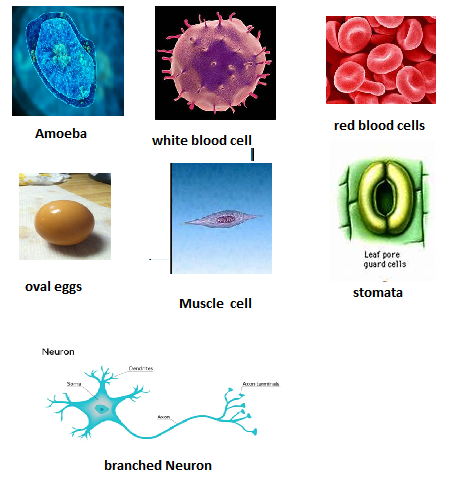
Shape of cells
The shape can be fixed or can be variable.
The cells with Variable shape are WBC (white blood cell) and Amoeba.
Please do remember that “the shape of the cell depends upon the function it performs”.
Different Shapes that the cell can have: –
Spherical => eggs of many animals
Spindle shaped => smooth muscle fiber
Elongated => nerve cell
Branched => cells of skin
Discoid => RBC.
Size of cell
Sizes also show a lot of variations. We have cell that is too tiny like PPLO to largest cell in the form of an ostrich egg
Smallest cell – Mycoplasm largest cell – Ostrich egg
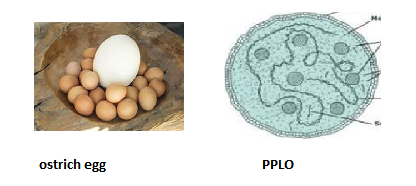
In Human body the smallest cell is: – RBC and longest /largest is Nerve cell .Nerve cell is designed accordingly to function it performs. As we cleared above also shapes are in accordance to function. Like, nerve cell help in transmission of impulse. So, it has to be long and branched.
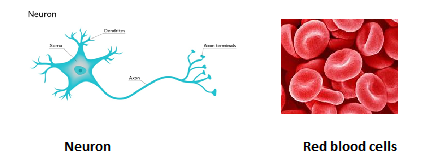
Cell number
The number of cells also varies from species to species. There can be organism made up of one cell and there can also be organism like us whose body is made up of many cells. Depending upon the number of cells present, cells are of two types:
- Unicellular
- Multicellular
Unicellular organisms – are single celled body (example Amoeba).
Multicellular – are multi-celled body that is many cells (example Man)
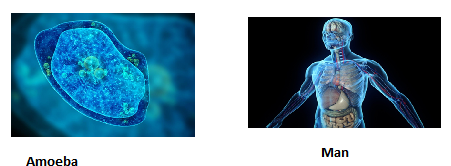
Structure of cell
If we look at the structure of cell we have already seen that all cells have three things in common:
- Cell membrane
- Nuclear material
- Metabolic machinery.
Let us study about cell membrane first:
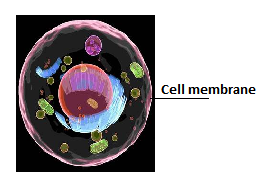
| Chapter 7 Diversity in Living Organisms | Chapter 8 Motion | Chapter 9 Force and Laws of Motion |
| Chapter 10 Gravitation | Chapter 11 Work and Energy | Chapter 12 Sound |
Cell membrane and cell wall
This gives a covering to all cells and the characteristics that it possess are listed below :
* It is present in both plant & animal cell
* It is an outer covering of cell
* It is living, thin and delicate membrane.
* It is semi-permeable – “allows selective particle to pass through.”
* It is made up of lipids & proteins.
It allows only selected substances to move through it .The movement of substances takes place by activities like: –
- Diffusion – “movement of molecules from higher concentration to lower concentration”. It is mostly seen in case of Gases. For example: Cell respire i.e. intake of O2 & giving out CO2 take place through diffusion.
- Osmosis: “movement of solvent molecules from higher cone. to lower conc. across the semipermeable membrane.
Functions of plasma membrane are as follows-
a) It provides support to cell
b)It allow exchange of materials.
c) It provides shape to the cell.
In plant cells outer to cell membrane another layer or covering is present called as cell wall. It is present in all plant cells .It is somehow different from cell membrane in many aspects as it is listed below .
Cell wall
- It is outer to cell membrane
- It is dead
- It is present only in plant cell
- It is made up of cellulose (in fungus it is made of chitin)
- It is freely permeable
Functions of cell wall are as follows –
- It provides mechanical support to cell.
- It allows materials to exchange.
- It maintains the shape of cells.
Now, if we go into detail, we can say that cell consist of cell membrane and it encloses called a living material protoplasm. Protoplasm is defined as living material of cell. The term protoplasm was coined by: J.E Purkinjee.
It is further divided into two parts:
- Nucleus (discovered by Robert Brown)
- Cytoplasm
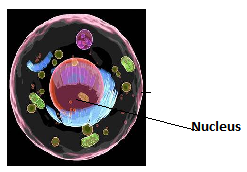
Nucleus
Like we have brain, the cell has a nucleus. All the activities are controlled by nucleus. It is located in the centre of the cell.
It consists of different components:
- Nuclear membrane
- Nucleoplasm
- Nuclear material
- Nucleolus
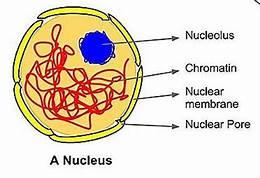
- Nuclear membrane: -It is the membrane that separates the nucleus from the cytoplasm. The membrane has pores in it which allow only selected exchange of materials. It is therefore called semi permeable in nature.
- Nucleoplasm: It is the liquid in the nucleus that is cytoplasm of nucleus. It is similar to cytoplasm outer to nucleus except that it lacks organelles.
- Nucleolus: It is a small oval body rich in proteins and RNA, RNA is ribonucleic acid and it is the genetic material. It is site for ribosome formation. That is why it is often termed as factory for ribosome.
- Nuclear material: It contains thread like structures which further condense at the time of cell division to ribbon like structures called chromosomes. These chromosomes are made up of DNA and proteins. There are segments of DNA that are responsible for characters in a body or transfer of characters from parents to offspring and are called genes. They act as hereditary vehicles.
Functions of nucleus are as follows-
- It regulates the cell cycle.
- It controls metabolic activities of cell.
- It contains genes that help in transmission of characters from parents to offspring .
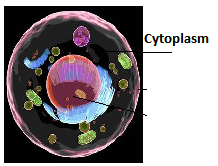
Cytoplasm
It is the liquid material of cell. Its soluble part is called cytosol. It contains organelles. These organelles perform necessary functions for the cell like some organelles help in cleaning the cell, some help in synthesizing certain substances for the cell, some perform catabolic function like breakdown of food, etc. Let us study them in detail:
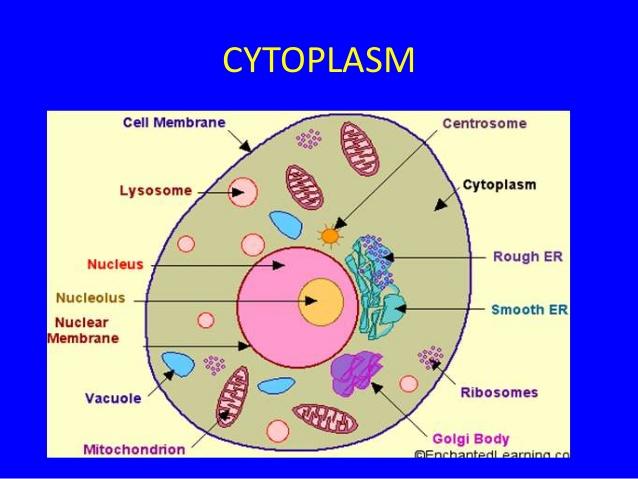
Cell organelles and their functions
There are many types of organelles that help the cell in performing different functions. The different organelles are :
- Endoplasmic reticulum
- Ribosome
- Golgi bodies
- Lysosomes
- Mitochondria
- Plastids
- Vacuole
- Centrosome
Let us study them in detail:
1. Endoplasmic reticulum
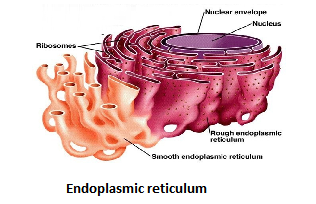
It is an irregular network of membranes enclosing fluid in its cavity .they are of two types that is:
- Rough endoplasmic reticulum(RER)
- Smooth endoplasmic reticulum(SER)
The basic difference between the two is that:
- RER – It has ribosomes attached to it.
- SER : – No ribosome are attached
Functions of endoplasmic reticulum are as follows –
- SER helps in synthesizing fats etc.
- Endoplasmic reticulum forms skeleton framework of cell.
- Rough endoplasmic reticulum helps in transportation of proteins.
- Smooth endoplasmic reticulum helps in detoxification.
- Oxidative enzymes of lysosomes are produced by Rough endoplasmic reticulum.
- Endoplasmic reticulum helps in formation of membrane of cell .That is :
RER – SER – Golgi body – sec. vesicles – p membrane
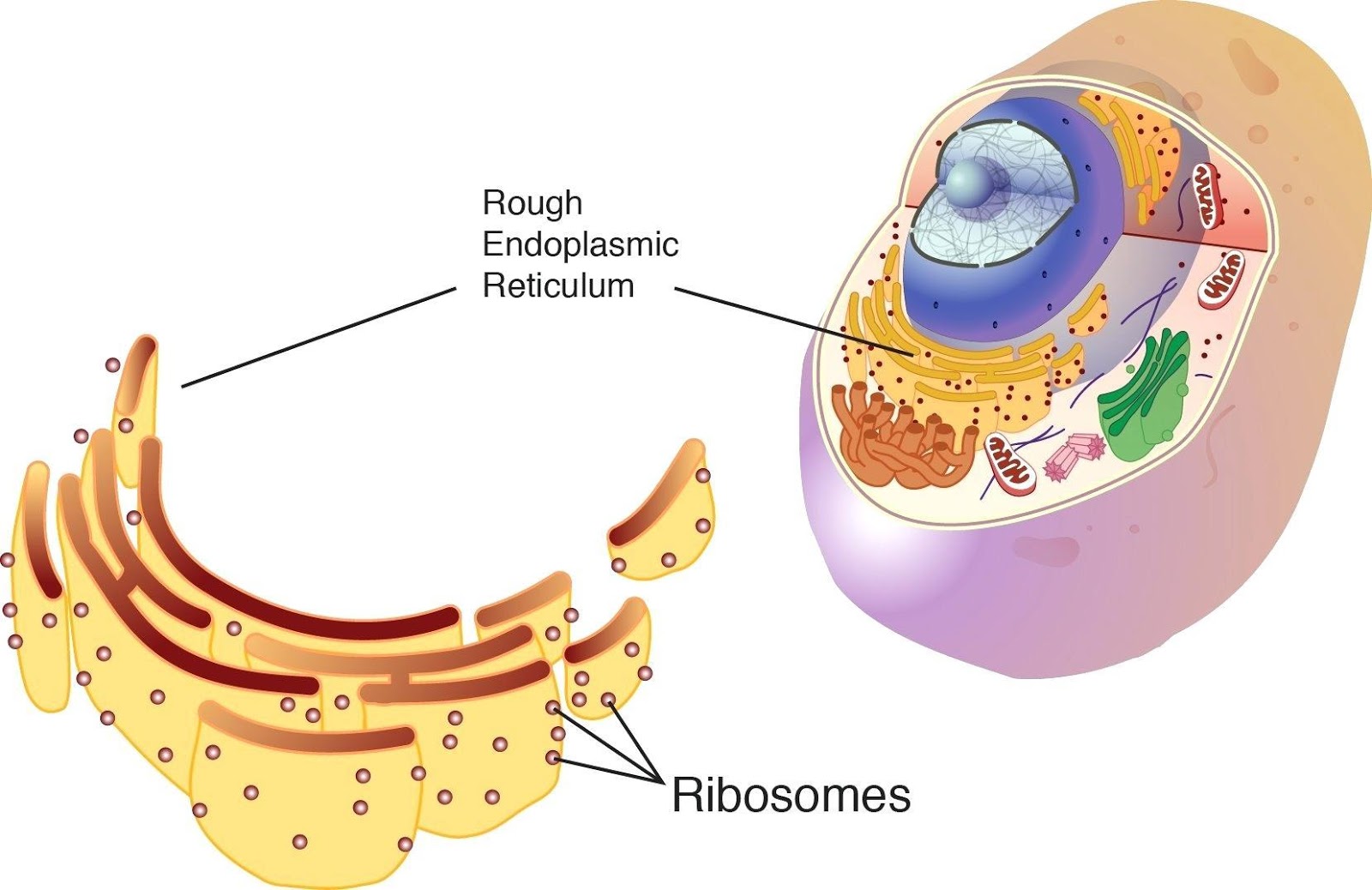
2. Ribosome
They are present in plant as well as in animal cell. They are spherical particles found free or attached to Rough Endoplasmic Reticulum. They contain their own genetic material that is RNA & proteins .Their function is protein synthesis. Due to the reason they are called as factory of proteins.
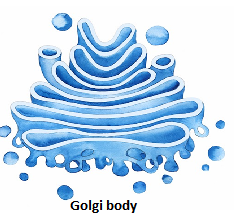
3. Golgi bodies
This organelle is present in plant and animal cells both. They are membrane bound fluid filled vesicles and flattened membranes stacked over one another called cisternae. In plant cells it is called by a special name that is Dictyosome.
Function: They secrete, packages and dispatch the cellular secretions and also helps in the formation of cell membrane.
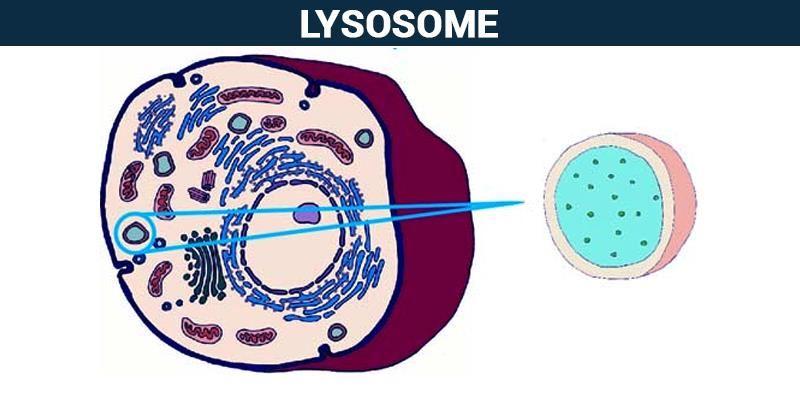
4.Lysosomes
They are present in plant as well as in animal cell. They are membrane bound vesicle containing powerful digestive enzymes. These enzymes can carry out the catabolic function
Function: Its functions are:
- They can destroy foreign material.
- They can remove worn out parts of the cell.
It acts as suicidal bags as they can even eat up their own cells if in case it gets damaged.
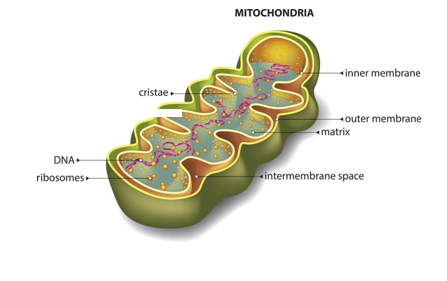
5. Mitochondria
They are rod shaped structures having a double membrane.
Its outer membrane is – porous
Its inner membrane is folded to form cristae & contain small bodies called oxysomes.
It has a cavity that is filled with matrix (fluid) containing DNA and ribosomes.
Its function is to produce energy in the form of ATP (Adenosine triphosphate) and is also designated as called as Power House of cell (due to production of energy).
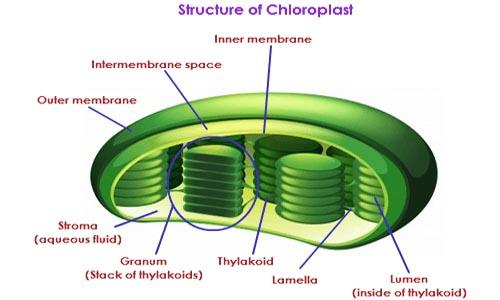
6. Plastids
These are only found in plant cells. They are of three types: –
- Leucoplast – It is colorless plastid.
- Chromoplast – It is colored plastid.
- Chloroplast –It is green colored plastid.
As you all know that plants have the ability to synthesize their own food. They do so with the help of pigment chlorophyll. This chlorophyll is present in organelle chloroplast.
Chloroplasts are double membrane organelles containing liquid stoma and stacked structures called lamellae. When lamellae are stacked over one another they give rise to grana. Grana contain green pigment chlorophyll. This chlorophyll actually helps in capturing solar energy and converting it to chemical energy of food.
Functions of plastids are as follows –
- Chloroplast helps in photosynthesis
- Leucoplast – stores food, fats etc.
- Chromoplast impart colour to flowers.
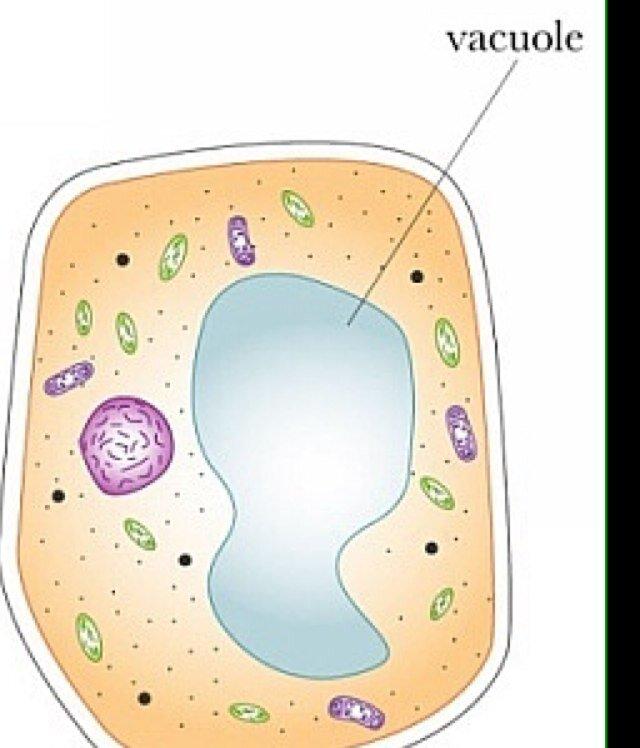
7. Vacuole
They are fluid filled membrane bound spaces. They are prominent and large in plants but in animal cell they are either absent or if present they are small and temporary. In animal cell it helps in storing substances.
In plant cell vacuole are large & permanent. Outer membrane is called as tonoplast and is filled with fluid called cell sap
Functions of vacuole are as follows-
- It provides turgidity & rigidity to cell.
- It stores substances.
- It maintains the osmotic pressure of cell.
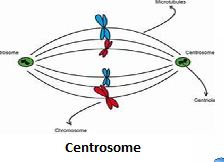
8. Centrosome
It is found only in animal cell. It consists of two granules called centrioles. The function of centrioles is to help in spindle formation during cell division.
Transportation of substances
As we have seen that substances move in and out from the cell. These exchange mainly occur by two processes:
- Diffusion
- Osmosis
| Chapter 13 Why do we fall ill | Chapter 14 Natural Resources |
| Chapter 15 Improvement in Food Resources |
Diffusion and Osmosis
Diffusion: It is the movement of any substance from higher concentration to lower concentration.
Have you noticed the fragrance of your favorite food at your home when it surprisingly cooked for you by your mom.
This is due to the process diffusion. When it is being cooked in kitchen its fragrant molecules from kitchen start moving out into the kitchen’s surroundings and with time get dispersed in the air .
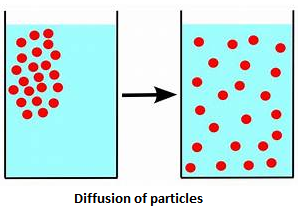
The diffusion is seen in solids, liquids and gases but the rate of diffusion is faster in gases. This is because gas particles are energetic as they possess high kinetic energy. The movement of gases in and out from the cell occurs by diffusion.
Osmosis: It is the movement of pure liquid from higher concentration to lower concentration across the semipermeable membrane .

For example: if you take two flasks and fill one with low sugar solution and other flask with highly concentrated sugar solution. Both the beakers are separated by a semipermeable membrane. Then we will notice that the water will move from the beaker where it is more to the side where it is less. The membrane allows only water to pass through it not sugar as it is semi-permeable that is selectively permeable.
Top
Types of solutions
We can make three different types of solutions that is :
- Hypotonic solution – The solution that has higher water concentration.
- Hypertonic solution- The solution that has less water concentration.
- Isotonic solution-The solution that has the same concentration of water as in cell.
Now let’s do an activity in which we will be placing a cell say red blood cell in three different solutions. Let’s see what happens:
Cells placed in different types of solutions
Have you seen that Red blood cell in hypotonic solution looks turgid?
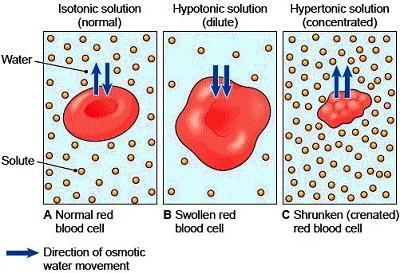
This is because when it is placed in a hypotonic solution, the water from solution moves into cell (endo-osmosis) due to which cell starts swelling up .The fully swollen cell in which the protoplasm almost touches the cell membrane is called Turgid cell.
Have you seen the red blood cell kept in hypertonic solution looks flaccid
This is because when it is placed in a hypertonic solution, the water from cell moves into solution (exo-osmosis) occurs due to which cell starts shrinking up .The cell whose protoplasm almost gets shrunk is called flaccid cell.
Have you seen the cell in isotonic solution
It remains as such. Nothing happens. The reason being the concentration of cell and a solution is the same.
Q. Have you noticed that sometimes when you forget to water plants especially in summers they droop, dry and ultimately they are about to die .
A. This is because the water from the plant is moving out due to transpiration. So, when there is no water left in them they start to droop. This basically occurs due to exo-osmosis. But when it is watered again, the endo osmosis occurs and it again become turgid .this is called plasmolysis (shrinkage) and deplasmolysis (again becoming healthier).
Top
The Fundamental Unit of Life Class 9 Question and Answers
Q1. Who discovered cell and how?
Ans: Robert Hooke, in 1665 discovered cell in thin slices of cork under the microscope. He observed that cork resembles the structure of honeycomb consisting of many compartments and that are called cells.
Q2. Why cell is called structural and functional unit of life?
Ans: Cells are arranged in proper systematic order to form a living organism thus we say cell serves as a building block for organisms. Cells are also called functional unit because all the metabolic activities of life takes place at the cell level.
Q3. How do substances like carbon dioxide and water move in and out from the cell?
Ans: They move in or out of the cell by the process of diffusion. There is spontaneous movement of substances from higher concentration to lower concentration. When this movement involves use of semi permeable membrane then it is called osmosis.
Q4. Difference between prokaryotic and eukaryotic cell?
| Prokaryotic cell | Eukaryotic cell |
|
|
|
|
|
|
Example: bacteria ,blue green algae, etc |
Example: Man etc. |
Q5. How Amoeba obtains its food?
Ans: Amoeba obtains its food by pseudopodia.
The plasma membrane of amoeba is flexible and enables the cell to engulf the food and form a cup shaped structure called pseudopodia by the process of endocytosis.
Q6. Differentiate between plant cells and animal cells ?
| Plant cell | Animal cell |
| 1. It has a cell wall made up of cellulose | 1. It doesn’t have cell wall |
| 2. It has plastids | 2. It lack plastids |
| 3. The vacuole is of large size | 3. The vacuole is either absent and if present then it is of small size |
| 4. Centrosome absent | 4. Centrosome present |
| 5. The food is stored in the form of starch and glycogen | 5. The food is stored in the form of glycogen |
Q7. Can you name two organelles that have their own genetic material?
Ans: Chloroplast and Mitochondria
Q8. If the organization of cell is destroyed due to some physical or chemical influence, what would happen?
Ans: If the organization of cell is destroyed due to some physical or chemical influence, Cell will die.
Q9. Why are lysosomes called suicidal bags?
Ans: Lysosomes are called suicidal bags because they can eat up their own cell if in case it gets damaged.
Q10. Where protein synthesis occurs in the cell?
Ans: Protein synthesis occurs in Ribosome.
Q11. What would happen if cell doesn’t have Golgi bodies?
Ans: The Golgi body helps in secretion, packaging and dispatching of cellular secretion.If it is not present then his will not occur.
Q12. Which organelle is called as power house of cell and why?
Ans: Mitochondria is called so because in it oxidation of food occurs and it produces energy in the form of ATP.
Q13. Where do lipids and proteins constituting the cell membrane get synthesized?
Ans: Proteins are made by ribosome and lipids by SER.
Q14. What is osmosis?
Ans: It is the movement of water from higher concentration to lower concentration across the semipermeable membrane.
Q15. Carry out the following experiment:
Take four peeled potato halves and hollow each one out to make potato cups .One of these cups should be made from a boiled potato .Put each potato cup in a trough containing water .Now,
- Keep cup A empty
- Put one teaspoon sugar in cup B
- Put one teaspoon salt in cup C
- Put one teaspoon sugar in boiled potato cup D
Keep the set up for 2 hours and observe four potato cups and answer:
- Explain why water gathers in the hollowed portion of B and C.
- Why is the potato a necessary for this experiment?
- Explain why water doesn’t gather in hollowed portions of potato A and D.
- The water gathers in hollowed portion of potato cups B and C due to osmosis.
- Cup A acts as control experiment and indicates that cavity of potato will not induce any type of movement.
- Cup A does not contain hypertonic solution hence water does not rise .In cup D, cells of potato cup being boiled cells are dead and no osmosis occurs.
| Class 9th English Lessons | Class 9th English Mcq | Take Class 9 MCQs |
| Class 9th Hindi Lessons | Class 9th Hindi Mcq | Take Class 9 MCQs |
| Class 9th Science Lessons | Class 9th Science Mcq |